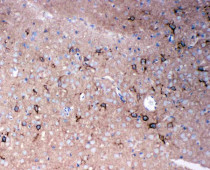ARG42927
anti-TNR / Tenascin R antibody
anti-TNR / Tenascin R antibody for IHC-Formalin-fixed paraffin-embedded sections and Rat
Overview
| Product Description | Rabbit Polyclonal antibody recognizes TNR / Tenascin R |
|---|---|
| Tested Reactivity | Rat |
| Tested Application | IHC-P |
| Host | Rabbit |
| Clonality | Polyclonal |
| Isotype | IgG |
| Target Name | TNR / Tenascin R |
| Antigen Species | Mouse |
| Immunogen | Synthetic peptide corresponding to aa. 104-117 of Mouse TNR / Tenascin R. (QTSDHESQVTFTHK) |
| Conjugation | Un-conjugated |
| Alternate Names | Restrictin; Janusin; Tenascin-R; TN-R |
Application Instructions
| Application Suggestion |
|
||||
|---|---|---|---|---|---|
| Application Note | * The dilutions indicate recommended starting dilutions and the optimal dilutions or concentrations should be determined by the scientist. |
Properties
| Form | Liquid |
|---|---|
| Purification | Affinity purification with immunogen. |
| Buffer | 0.2% Na2HPO4, 0.9% NaCl, 0.05% Thimerosal, 0.05% Sodium azide and 5% BSA. |
| Preservative | 0.05% Thimerosal and 0.05% Sodium azide |
| Stabilizer | 5% BSA |
| Concentration | 0.5 mg/ml |
| Storage Instruction | For continuous use, store undiluted antibody at 2-8°C for up to a week. For long-term storage, aliquot and store at -20°C or below. Storage in frost free freezers is not recommended. Avoid repeated freeze/thaw cycles. Suggest spin the vial prior to opening. The antibody solution should be gently mixed before use. |
| Note | For laboratory research only, not for drug, diagnostic or other use. |
Bioinformation
| Database Links | |
|---|---|
| Gene Symbol | TNR |
| Gene Full Name | tenascin R |
| Background | This gene encodes a member of the tenascin family of extracellular matrix glycoproteins. The encoded protein is restricted to the central nervous system. The protein may play a role in neurite outgrowth, neural cell adhesion and modulation of sodium channel function. It is a constituent of perineuronal nets. [provided by RefSeq, Aug 2013] |
| Function | Neural extracellular matrix (ECM) protein involved in interactions with different cells and matrix components. These interactions can influence cellular behavior by either evoking a stable adhesion and differentiation, or repulsion and inhibition of neurite growth. Binding to cell surface gangliosides inhibits RGD-dependent integrin-mediated cell adhesion and results in an inhibition of PTK2/FAK1 (FAK) phosphorylation and cell detachment. Binding to membrane surface sulfatides results in a oligodendrocyte adhesion and differentiation. Interaction with CNTN1 induces a repulsion of neurons and an inhibition of neurite outgrowth. Interacts with SCN2B may play a crucial role in clustering and regulation of activity of sodium channels at nodes of Ranvier. TNR-linked chondroitin sulfate glycosaminoglycans are involved in the interaction with FN1 and mediate inhibition of cell adhesion and neurite outgrowth. The highly regulated addition of sulfated carbohydrate structure may modulate the adhesive properties of TNR over the course of development and during synapse maintenance (By similarity). [UniProt] |
| Cellular Localization | Secreted, extracellular space, extracellular matrix. [UniProt] |
| Calculated MW | 150 kDa |
| PTM | Contains N-linked oligosaccharides, O-linked sialylated structures and O-linked chondroitin sulfate glycosaminoglycans. Contains N-linked oligosaccharides with a sulfated carbohydrate structure (By similarity). O-glycosylated on Thr-36 or Thr-37 with a core 1 or possibly core 8 glycan. [UniProt] |
Images (1) Click the Picture to Zoom In






